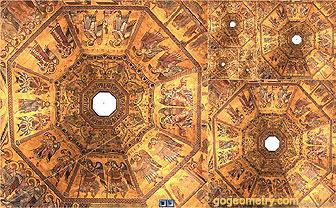Unveiling the Hidden Geometry of the Florence Cathedral's Dome Ceiling: The Golden Rectangles and the Art of Aesthetically Pleasing Design

The square section of the Dome forming successive Golden Rectangles.
Florence Cathedral: The Dome, Duomo
The Florence Cathedral, also known as the Duomo, is a
world-renowned cathedral located in Florence, Italy. One of
the most notable features of the Duomo is its dome ceiling,
which was designed by Filippo Brunelleschi in the early 15th
century.
The geometry of the Florence
Cathedral's dome ceiling is a masterpiece of
Renaissance architecture and engineering. The dome itself is
made up of two shells, an inner and outer dome, with a total
height of 114 meters (375 feet).
One of the most
fascinating geometric aspects of the dome is its use of the
golden ratio and golden rectangles. The
ribs of the dome, which support its weight and provide its
structural integrity, are arranged in a series of golden
rectangles. These rectangles are created by dividing the
height of the dome into sections that are in the golden
ratio.
The use of the golden ratio is not limited to
the ribs of the dome, however. The design of the dome's
windows, for example, is also based on the golden ratio. The
size and shape of the windows are carefully proportioned to
create a sense of balance and harmony in the overall design.
Another important geometric feature of
the dome is its shape. The dome is not a perfect hemisphere,
but rather a complex shape that combines elements of a dome
and a pointed arch. This shape was necessary to accommodate
the structural requirements of the dome, while also creating
an aesthetically pleasing form.
Overall, the geometry
of the Florence Cathedral's dome ceiling is a testament to
the genius of its designers and engineers, and to the
enduring beauty of the golden ratio in art and architecture.
Golden rectangle
A golden rectangle
is a rectangle whose side lengths are in the golden ratio,
one-to-phi, that is, approximately 1:1.618. A distinctive
feature of this shape is that when a square section is
removed, the remainder is another golden rectangle, that is,
with the same proportions as the first. Square removal can
be repeated infinitely, which leads to an approximation of
the golden or Fibonacci spiral.
Droste Effect
In the context of the Florence Cathedral, the Droste
effect can be seen in the decoration of the dome's lantern
at the top. The lantern features an image of the cathedral
itself, which appears to repeat itself infinitely in a
circular pattern.
The design of the lantern was created
by Andrea del Castagno in the 15th century, and it is
believed that he may have been inspired by the mathematical
principles used in the construction of the dome. The
repeated image of the cathedral in the lantern creates a
sense of visual depth and complexity, while also referencing
the cathedral's own architectural history.
Overall, the
use of the Droste effect in the Florence Cathedral's lantern
is a fascinating example of how art and geometry can
intersect to create visually stunning and conceptually rich
works of art.

|